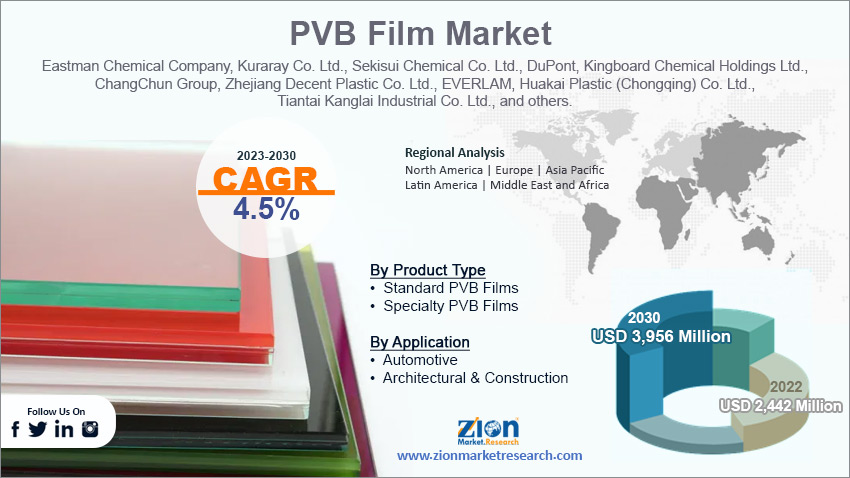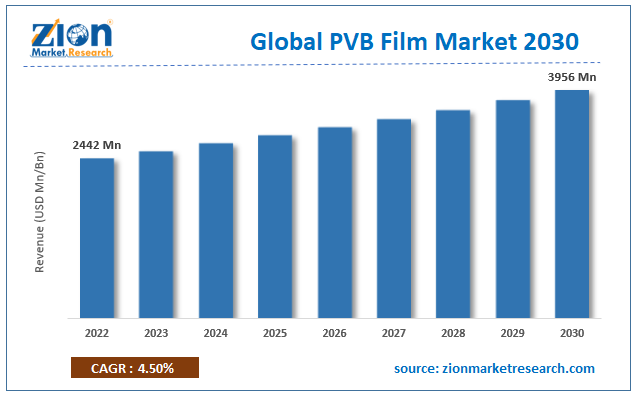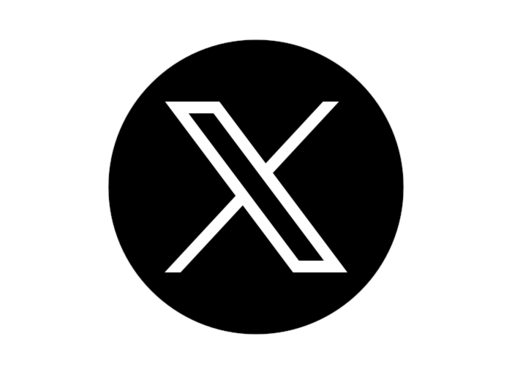Global PVB Film Market Size, Share, Analysis, Trends, Growth Report, 2030

Global PVB Film Market By Product Type (Standard PVB Films and Specialty PVB Films), By Application (Automotive (windshields, side windows) and Architectural & construction (windows, doors, laminated glass)), and By Region - Global and Regional Industry Overview, Market Intelligence, Comprehensive Analysis, Historical Data, And Forecasts 2023 - 2030-
| Market Size in 2022 | Market Forecast in 2030 | CAGR (in %) | Base Year |
|---|---|---|---|
| USD 2,442 Million | USD 3,956 Million | 4.5% | 2022 |
PVB Film Industry Prospective:
The global PVB film market size was worth around USD 2,442 million in 2022 and is predicted to grow to around USD 3,956 million by 2030 with a compound annual growth rate (CAGR) of roughly 4.5% between 2023 and 2030.
Global PVB Film Market: Overview
Polyvinyl butyral (PVB) film is a thermoplastic that is commonly used to produce laminated glass. PVB film offers excellent durability, adhesion, and optical clarity since it is constructed of butyral and polyvinyl acetal resin. One of its primary uses is as an interlayer between glass panes in safety glass for vehicles and structures. When glass breaks, the PVB film holds the fragments together, reducing the risk of shards harming you. Furthermore, because it filters harmful UV radiation and works as sound insulation, PVB film is a flexible material that may be utilized to improve the safety and performance of a wide range of glass applications. Outside, PVB film is used in solar panels, photovoltaic modules, and electronic displays, among other things.
Key Insights
- As per the analysis shared by our research analyst, the global PVB film industry is estimated to grow annually at a CAGR of around 4.5% over the forecast period (2023-2030).
- In terms of revenue, the global PVB film market size was valued at around USD 2,442 million in 2022 and is projected to reach USD 3, 956 million, by 2030.
- The global PVB film market is projected to grow at a significant rate due to the increasing need for ecologically friendly and safe solutions in the automotive and construction industries.
- Based on product type segmentation, standard PVB films were predicted to hold maximum market share in the year 2022.
- Based on application segmentation, automotive (windshields, side windows) were the leading revenue generator in 2022.
- On the basis of region, Asia Pacific was the leading revenue generator in 2022.
 Request Free Sample
Request Free Sample
Global PVB Film Market: Growth Drivers
Growing demand for safety and security solutions is driving market growth
As safety laws tighten, demand for safety and security solutions rises, and laminated glass—which employs PVB film as the interlayer—becomes increasingly vital. This film enhances the structural integrity of windshields and windows in the automobile sector by keeping shattered glass from spreading, minimizing the risk of injury during crashes. Since 2004, all new vehicles sold in the European Union have had laminated windshields using PVB film. Furthermore, top manufacturers such as Tesla and Mercedes-Benz are increasingly employing PVB film in their vehicles to provide cutting-edge features such as increased thermal insulation and noise reduction. Similarly, PVB film is used in the construction sector in laminated glass to increase building safety by providing resistance to natural catastrophes, break-ins, and unintentional fires.
In 2022, the use of PVB film in the US building sector climbed by 7% over the previous year. Furthermore, the global PVB film industry is developing as people become more aware of, and concerned about, sustainability and energy efficiency. Because of its protective and transparent features, PVB film is vital in the production of photovoltaic modules for solar panels, which improve the life and efficiency of solar cells. As governments throughout the world fight for sustainable energy, the renewable energy sector continues to develop.
Global PVB Film Market: Restraints
The volatility in raw material prices is restraining the growth of the market
Since PVB film is created from petrochemical raw materials, changes in their prices might have an impact on the entire production costs of manufacturers. As a result, enterprises in the PVB film sector may struggle to maintain constant profit margins and long-term strategic planning may be impeded due to the unpredictability of material costs. Because it is dependent on petroleum-based feedstocks, the global PVB film industry is vulnerable to geopolitical events, the status of the global economy, and other variables that impact raw material pricing dynamics. This constraint underlines the need for market participants to employ effective cost-management measures and investigate other more dependable raw material sources in order to mitigate the consequences of price volatility.
Global PVB Film Market: Opportunities
Increasing focus on sustainable and eco-friendly solutions across industries to provide growth opportunities
Materials having a lower environmental effect are becoming more popular as environmental problems gain traction. PVB film manufacturers may capitalize on this trend by developing and selling ecologically friendly equivalents, such as recyclable or bio-based PVB films. In addition to aligning with global environmental goals, the implementation of sustainable practices attracts environmentally concerned clients and organizations in the automotive, construction, and other industries looking for more environmentally friendly solutions. Furthermore, due to ongoing developments in research and technology, the PVB film business offers the potential for innovation. Businesses may invest in R&D to increase the strength, optical clarity, and insulating capabilities of PVB films, among other performance characteristics.
Manufacturing technique advancements, such as the development of intelligent and usable PVB films, have the potential to increase the area of applications and provide an industrial competitive edge. By grasping technical possibilities, PVB film makers may stay ahead of industry trends and fulfill evolving consumer needs for high-performance and sustainable solutions.
Global PVB Film Market: Challenges
Competition from alternative materials and technologies to challenge market growth
Industries are constantly seeking for new methods to address issues, and one way to do so is to look for alternatives that may give better or equal performance. Novel materials, such as interlayers made of ionoplast polymers or thermoplastic polyurethane (TPU), represent a challenge to traditional PVB films. Manufacturers in the PVB film industry must constantly improve their products, look into new applications, and set themselves apart with features such as enhanced transparency, durability, or environmental sustainability in order to maintain their market share in the face of shifting industry preferences.
Global PVB Film Market: Segmentation
The global PVB film market is segmented based on product type, application, and region.
Based on product type, the global industry segments are standard PVB films and specialty PVB films.
The standard PVB films category now dominates the global market. Because it is extensively utilized in many different industries, including as construction and the car industry, the segment of standard PVB films is the most dominating in the global industry. Because they provide critical properties such as adhesion, durability, and optical clarity, standard PVB films are a cheap and trustworthy solution for laminated glass applications. These films have gained popularity because they meet the essential safety criteria for architectural glass and vehicle windshields.
Based on application the global PVB film market is categorized as automotive (windshields, side windows) and architectural & construction (windows, doors, laminated glass). Automotive (windshields, side windows) was the largest shareholder category in the global market. PVB films are widely employed in the automobile sector to fulfill regulatory criteria and increase safety, which explains their dominance. Side windows and windshields are guaranteed to remain intact during crashes when PVB films are used to form laminated glass, lowering the chance of glass shatter injuries.
PVB Film Market: Report Scope
| Report Attributes | Report Details |
|---|---|
| Report Name | PVB Film Market |
| Market Size in 2022 | USD 2,442 Million |
| Market Forecast in 2030 | USD 3,956 Million |
| Growth Rate | CAGR of 4.5% |
| Number of Pages | 202 |
| Key Companies Covered | Eastman Chemical Company, Kuraray Co. Ltd., Sekisui Chemical Co. Ltd., DuPont, Kingboard Chemical Holdings Ltd., ChangChun Group, Zhejiang Decent Plastic Co. Ltd., EVERLAM, Huakai Plastic (Chongqing) Co. Ltd., Tiantai Kanglai Industrial Co. Ltd., and others. |
| Segments Covered | By Product Type, By Application, and By Region |
| Regions Covered | North America, Europe, Asia Pacific (APAC), Latin America, Middle East, and Africa (MEA) |
| Base Year | 2022 |
| Historical Year | 2017 to 2021 |
| Forecast Year | 2023 - 2030 |
| Customization Scope | Avail customized purchase options to meet your exact research needs. Request For Customization |
Global PVB Film Market: Regional Analysis
Asia Pacific to lead the market during the forecast period
The Asia Pacific region is expected to dominate the global PVB film market during the projected period due to a number of major factors driving demand in the area. Growing building activity as a result of rapid urbanization, notably in China and India, has stimulated the use of PVB film in architectural applications such as windows and facades for safety and sound insulation. The market is predicted to increase rapidly due in part to the burgeoning automotive sector in Asia Pacific, particularly in emerging nations, due to PVB film's vital role in laminated glass, which passes high safety regulations and is used in vehicle windshields and windows. Furthermore, due to the rising usage of PVB film in the Asia Pacific area, PVB film offers another potential opportunity.
Key Developments
2023: Eastman and Sekisui, two leading participants in the global PVB film market, forged a strategic collaboration in 2023 to develop and sell sustainable PVB film solutions.
In 2023, DuPont de Nemours and Company's brand Saflex released a new PVB film with improved UV protection.
In 2023, Kuraray, another important market competitor, unveiled a new PVB film technology designed particularly for increased sound insulation.
Global PVB Film Market: Competitive Analysis
The global PVB film market is dominated by players like:
- Eastman Chemical Company
- Kuraray Co., Ltd.
- Sekisui Chemical Co., Ltd.
- DuPont
- Kingboard Chemical Holdings Ltd.
- ChangChun Group
- Zhejiang Decent Plastic Co., Ltd.
- EVERLAM
- Huakai Plastic (Chongqing) Co., Ltd.
- Tiantai Kanglai Industrial Co., Ltd.
The global PVB film market is segmented as follows:
By Product Type
- Standard PVB Films
- Specialty PVB Films
By Application
- Automotive (windshields, side windows)
- Architectural & Construction (windows, doors, laminated glass)
By Region
- North America
- The U.S.
- Canada
- Europe
- France
- The UK
- Spain
- Germany
- Italy
- Rest of Europe
- Asia Pacific
- China
- Japan
- India
- South Korea
- Southeast Asia
- Rest of Asia Pacific
- Latin America
- Brazil
- Mexico
- Rest of Latin America
- Middle East & Africa
- GCC
- South Africa
- Rest of Middle East & Africa
Table Of Content
Methodology
FrequentlyAsked Questions
Polyvinyl butyral (PVB) film is a thermoplastic that is commonly used to produce laminated glass. PVB film offers excellent durability, adhesion, and optical clarity since it is constructed of butyral and polyvinyl acetal resin. One of its primary uses is as an interlayer between glass panes in safety glass for vehicles and structures.
The global PVB film market cap may grow owing to increasing need for ecologically friendly and safe solutions in the automotive and construction industries.
According to study, the global PVB film market size was worth around USD 2,442 million in 2022 and is predicted to grow to around USD 3,956 million by 2030.
The CAGR value of the global PVB film market is expected to be around 4.5% during 2023-2030.
The global PVB film market growth is expected to be driven by Asia Pacific. It is currently the world’s highest revenue-generating market owing to growing building activity as a result of rapid urbanization, notably in China and India.
The global PVB film market is led by players like Eastman Chemical Company, Kuraray Co., Ltd., Sekisui Chemical Co., Ltd., DuPont, Kingboard Chemical Holdings Ltd., ChangChun Group, Zhejiang Decent Plastic Co., Ltd., EVERLAM, Huakai Plastic (Chongqing) Co., Ltd., and Tiantai Kanglai Industrial Co., Ltd.
The report analyzes the global PVB film market’s drivers, restraints/challenges, and the effect they have on the demands during the projection period. In addition, the report explores emerging opportunities in the PVB film industry.
Choose License Type
List of Contents
PVB FilmIndustry Prospective:GlobalOverviewKey InsightsGlobalGrowth DriversGlobalRestraintsGlobalOpportunitiesGlobalChallengesGlobalSegmentationPVB Film Report ScopeGlobalRegional AnalysisKey DevelopmentsGlobalCompetitive AnalysisThe global PVB film market is segmented as follows:By RegionHappyClients
Zion Market Research
Tel: +1 (302) 444-0166
USA/Canada Toll Free No.+1 (855) 465-4651
3rd Floor,
Mrunal Paradise, Opp Maharaja Hotel,
Pimple Gurav, Pune 411061,
Maharashtra, India
Phone No +91 7768 006 007, +91 7768 006 008
US OFFICE NO +1 (302) 444-0166
US/CAN TOLL FREE +1 (855) 465-4651
Email: sales@zionmarketresearch.com
We have secured system to process your transaction.
Our support available to help you 24 hours a day, five days a week.
Monday - Friday: 9AM - 6PM
Saturday - Sunday: Closed






